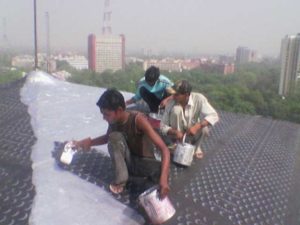We are a leading Service Provider of Heat Reducation Services from Delhi, India.
Heat Reducation services Good insulation not only prevents personal injuries and damage caused by fire, it also substantially contributes to the prevention of heat loss.
The pipes and installations in industrial plants often carry heated materials. These materials need to be kept at a certain temperature for an optimal production process. To achieve this, the materials are heated in different phases of the production process. When the pipes and installations are not properly insulated, heat loss occurs.
The total heat loss of an installation determines its energy consumption, and efficiency and the CO2 emission caused by its operation. The total heat loss also fundamentally influences the costs of air-conditioning and ventilation systems and is therefore a key topic in energy management. Technova Waterproofing Pvt. Ltd. Technical Insulation supplies stone wool products which are made especially to insulate installations with high temperatures. The insulation of hot pipes and other technical installations can result in up to 80% heat loss reduction. This depends on the thickness of the insulation and on the precision of application.
Much of the cost of cooling your home can be saved by passive cooling techniques which don’t require expensive retrofits or professional installations.Here are suggestions for free, or low-cost, ways to cool your home with less impact on the environment and your energy bill.
Blocking the Heat
The most effective ways to block heat from entering your home are insulation, reflective barriers and shading.
Insulation: Insulating, caulking and weatherstripping are essential to keeping your home warm in cold climates, but they also help keep your home cool in hot weather.
Turn off hot water circulating pump in summer. If you have a hot water circulating pump for instant hot water at all faucets consider turning off for the summer. Most homes don’t have insulated water lines and you pay both heating the water and removing the heat from your home with your air conditioning, the small inconvenience is worth it for energy conservation.
Seal ducts and close basement doors. Many homes with central heating have ducts which run through the attic and crawl space. If the seams in these ducts are leaky, especially in the attic, they can draw in hot summer air which flows into the house, creating more of a load for air conditioners. Minor duct repairs are easy to accomplish, and usually involve folding or crimping the tin edges with a pliers. Ducts in unconditioned spaces, however, should be sealed and insulated by qualified professionals using the appropriate sealing materials.
Air ducts which lead to your basement should also be shut off, as this part of your house usually cools itself naturally. Keep the door to the basement closed, as cool air will settle down to the basement where it isn’t needed.
Ventilate with a window fan. If outside temperature is below 77°, a window fan can be used to replace hot indoor air. Locate fan on the downwind side with fan blades directing the air outwards. To enhance air flow, open a window in each room and be sure all interior doors are open.
Shut gas supply to fireplace and heaters. The pilot light generates a considerable amount of heat, and should be off during warm months. Re-lighting the pilot light in the fall is as easy as pushing a button on most units. Fireplace dampers should also be closed during the hot months of the year; this minimizes the loss of cooler air from inside the home.
Other Details
- Hassle free management
- Best price deal
- Reliable solution
- Technova Waterproofing Pvt. Ltd.
- www.technovawaterproofing.com
